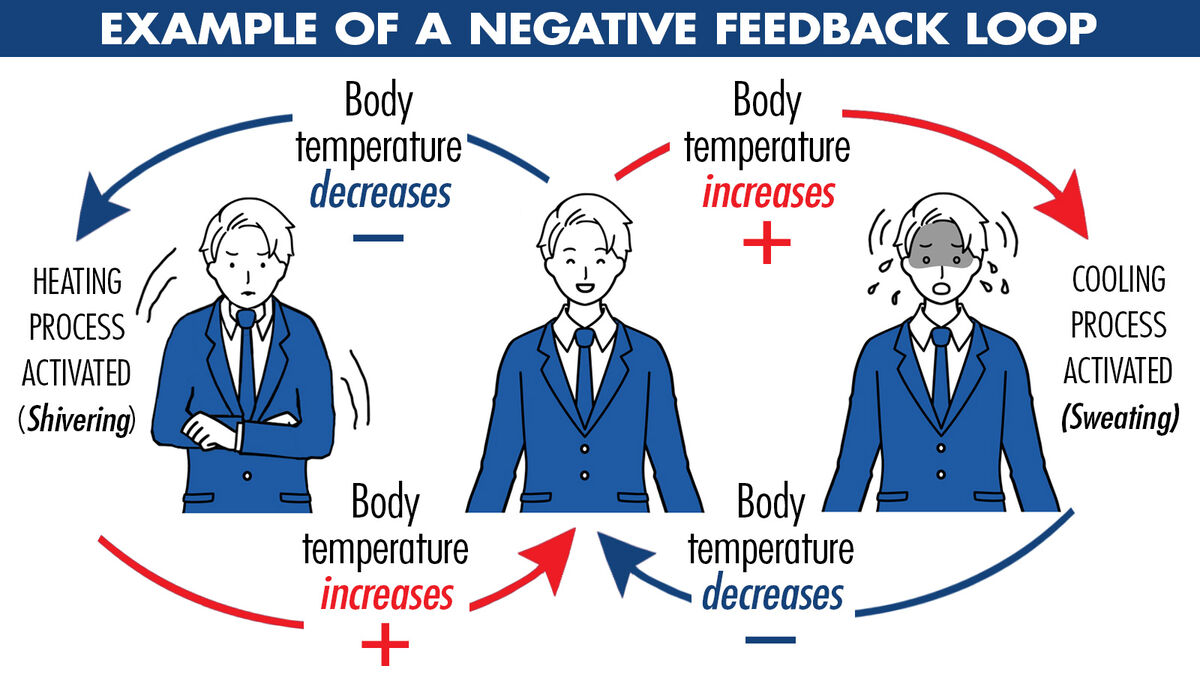
Feedback loops come in two different kinds: positive and negative. Negative feedback loops are more common and work to keep a system stabilized or at equilibrium. Learn more about what negative feedback is along with several examples of biological and mechanical negative feedback loops. You’ll also find out the difference between positive and negative feedback.
What Is a Negative Feedback Loop?
A negative feedback loop is a reaction that causes a decrease in function. It occurs in response to some kind of stimulus. Often, it causes the output of a system to be lessened; so, the feedback tends to stabilize the system. This can be referred to as homeostasis, as in biology, or equilibrium, as in mechanics.
Now that you’ve got an understanding of what negative feedback is, check out a few examples of negative feedback loops
Biological Negative Feedback
Your body has all different kinds of negative feedback loops. Explore a few different examples.
- Human body temperature - The hypothalamus of a human reacts to temperature fluctuations and responds accordingly. If the temperature drops, the body shivers to bring up the temperature and if it is too warm, the body will sweat to cool down due to evaporation.
- Human blood pressure - When blood pressure increases, signals are sent to the brain from the blood vessels. Signals are sent to the heart from the brain, and heart rate slows down, thus helping blood pressure to return to normal.
- Human metabolism - When a human is hungry, metabolism slows down to conserve energy and allows the human to continue living with less food.
- Regulation of blood sugar in humans - When blood sugar rises, insulin sends a signal to the liver, muscles, and other cells to store the excess glucose. Some is stored as body fat, and other glucose is stored as glycogen in the liver and muscles.
- Production of human red blood cells (erythropoiesis) - A decrease in oxygen is detected by the kidneys and they secrete erythropoietin. This hormone stimulates the production of red blood cells.
Negative Feedback in Nature
Dive into different negative feedback loops that you can find in nature.
- The carbon cycle - The equilibrium of this cycle will change in accordance with carbon dioxide emissions.
- Plant photosynthesis - The photosynthesis in plants speeds up in response to increased levels of carbon dioxide.
- Carbonation - Rain and carbon dioxide combine with limestone to make calcium bicarbonate. This increases when the temperature lowers and is a factor in glacial weathering.
- Population of predators and prey - If the numbers of prey decrease, then some predators will starve, and their numbers will decrease.
- Greenhouse effect - More radiation escapes into space from the upper atmosphere than from the lower portion. Global warming will reduce the rate of this escaping radiation, and this will lessen the greenhouse effect.
Mechanical Negative Feedback
Mechanics is also full of different physical negative feedback loops. Here are a few examples.
- Flushing a toilet - The ballcock in a toilet rises as the water rises, and then it closes a valve that turns off the water.
- The fly-ball governor - This was used in controlling the speed of a steam engine. Two balls were attached to a frame and as their rotational speed increased, they swung outward and closed the inlet valve for steam. That caused the engine to slow down.
- Water flow in rocks - Water flowing through a fracture in a rock will eventually deposit enough sediment to slow down the flow of the water.
- Thermostats - A thermostat senses the temperature and either turns the heater on or off.
- Springs - A spring can be compressed but will return to its original shape when pressure on it is released.
Positive and Negative Feedback
Whereas a negative feedback loop causes a decrease in function, a positive feedback loop will increase a function. It reinforces the change until the stimulus is removed. The best way to understand this is through examples.
- Childbirth is a positive feedback loop. During childbirth, the uterus will contract until the child is born.
- Blood clotting is another example because platelets will continue to be released to the injury site until the bleeding has stopped.
So to simplify, negative feedback decreases while positive feedback increases a function until a specific outcome is reached.
Understanding Negative Feedback Loops
Negative feedback loops can be hard to understand. But once you look at examples and how they compare to positive feedback loops, it makes more sense. Dive into more about biological processes by looking at examples of electrolytes.